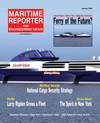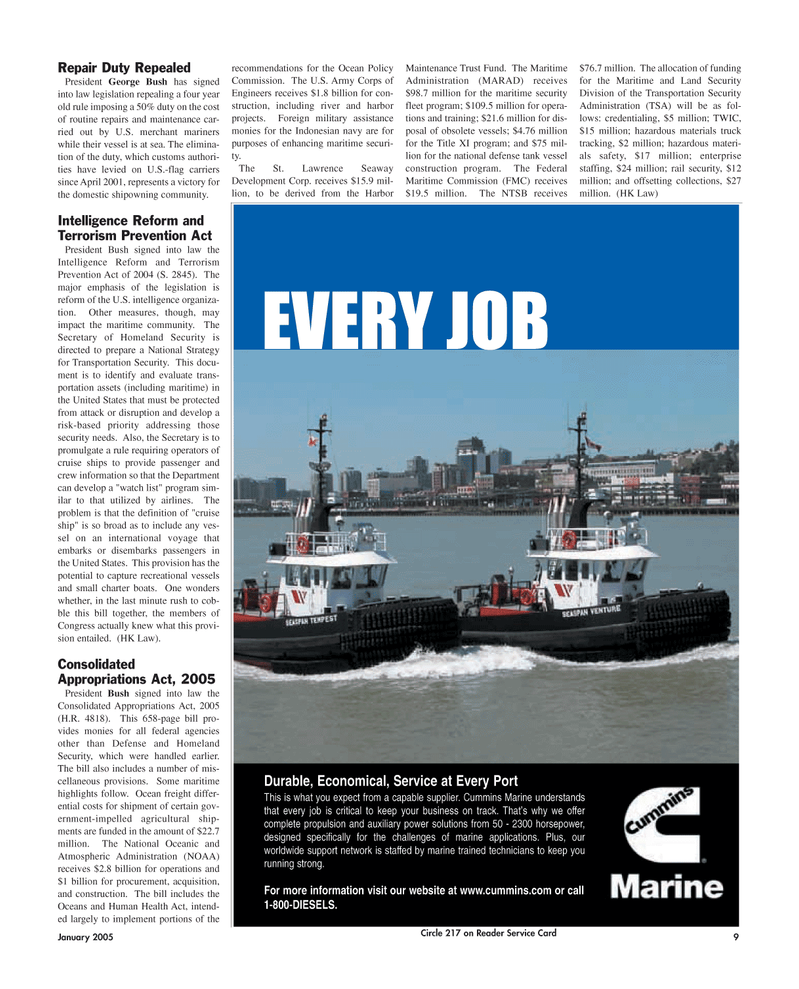
Page 9: of Maritime Reporter Magazine (January 2, 2005)
Read this page in Pdf, Flash or Html5 edition of January 2, 2005 Maritime Reporter Magazine
Repair Duty Repealed
President George Bush has signed into law legislation repealing a four year old rule imposing a 50% duty on the cost of routine repairs and maintenance car- ried out by U.S. merchant mariners while their vessel is at sea. The elimina- tion of the duty, which customs authori- ties have levied on U.S.-flag carriers since April 2001, represents a victory for the domestic shipowning community.
Intelligence Reform and
Terrorism Prevention Act
President Bush signed into law the
Intelligence Reform and Terrorism
Prevention Act of 2004 (S. 2845). The major emphasis of the legislation is reform of the U.S. intelligence organiza- tion. Other measures, though, may impact the maritime community. The
Secretary of Homeland Security is directed to prepare a National Strategy for Transportation Security. This docu- ment is to identify and evaluate trans- portation assets (including maritime) in the United States that must be protected from attack or disruption and develop a risk-based priority addressing those security needs. Also, the Secretary is to promulgate a rule requiring operators of cruise ships to provide passenger and crew information so that the Department can develop a "watch list" program sim- ilar to that utilized by airlines. The problem is that the definition of "cruise ship" is so broad as to include any ves- sel on an international voyage that embarks or disembarks passengers in the United States. This provision has the potential to capture recreational vessels and small charter boats. One wonders whether, in the last minute rush to cob- ble this bill together, the members of
Congress actually knew what this provi- sion entailed. (HK Law).
Consolidated
Appropriations Act, 2005
President Bush signed into law the
Consolidated Appropriations Act, 2005 (H.R. 4818). This 658-page bill pro- vides monies for all federal agencies other than Defense and Homeland
Security, which were handled earlier.
The bill also includes a number of mis- cellaneous provisions. Some maritime highlights follow. Ocean freight differ- ential costs for shipment of certain gov- ernment-impelled agricultural ship- ments are funded in the amount of $22.7 million. The National Oceanic and
Atmospheric Administration (NOAA) receives $2.8 billion for operations and $1 billion for procurement, acquisition, and construction. The bill includes the
Oceans and Human Health Act, intend- ed largely to implement portions of the recommendations for the Ocean Policy
Commission. The U.S. Army Corps of
Engineers receives $1.8 billion for con- struction, including river and harbor projects. Foreign military assistance monies for the Indonesian navy are for purposes of enhancing maritime securi- ty.
The St. Lawrence Seaway
Development Corp. receives $15.9 mil- lion, to be derived from the Harbor
Maintenance Trust Fund. The Maritime
Administration (MARAD) receives $98.7 million for the maritime security fleet program; $109.5 million for opera- tions and training; $21.6 million for dis- posal of obsolete vessels; $4.76 million for the Title XI program; and $75 mil- lion for the national defense tank vessel construction program. The Federal
Maritime Commission (FMC) receives $19.5 million. The NTSB receives $76.7 million. The allocation of funding for the Maritime and Land Security
Division of the Transportation Security
Administration (TSA) will be as fol- lows: credentialing, $5 million; TWIC, $15 million; hazardous materials truck tracking, $2 million; hazardous materi- als safety, $17 million; enterprise staffing, $24 million; rail security, $12 million; and offsetting collections, $27 million. (HK Law)
EVERY JOB g39g88g85g68g69g79g72g15g3g40g70g82g81g82g80g76g70g68g79g15g3g54g72g85g89g76g70g72g3g68g87g3g40g89g72g85g92g3g51g82g85g87
This is what you expect from a capable supplier. Cummins Marine understands that every job is critical to keep your business on track. That’s why we offer complete propulsion and auxiliary power solutions from 50 - 2300 horsepower, designed specifically for the challenges of marine applications. Plus, our worldwide support network is staffed by marine trained technicians to keep you running strong. g41g82g85g3g80g82g85g72g3g76g81g73g82g85g80g68g87g76g82g81g3g89g76g86g76g87g3g82g88g85g3g90g72g69g86g76g87g72g3g68g87g3g90g90g90g17g70g88g80g80g76g81g86g17g70g82g80g3g82g85g3g70g68g79g79 g20g16g27g19g19g16g39g44g40g54g40g47g54g17
January 2005 9
Circle 217 on Reader Service Card
MR JANUARY 2005 #2 (9-16).qxd 1/5/2005 2:37 PM Page 1

 8
8

 10
10
